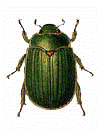Museum, University of Nebraska State
Date of this Version
4-24-1980
Abstract
Beetles that eat writhing maggots and the decaying flesh and putrefaction of dead animals . . . what could be more macabre, repulsive, and in poor taste? [Well, possibly beetles that eat feces and have a rolling good time doing it (see my January Museum Notes).] Carrion beetles are an important part of a vast host of scavengers that are responsible for breaking down and recycling back into the ecosystem the basic elements locked inside each one of us. If it were not for these industrious scavenger beetles, we might all be surrounded by the partially decayed and mummified remains of wildlife and domestic livestock that die each year.
The decay process is an efficient and natural system whereby the raw materials of dead organisms are returned directly into the energy budgets of living organisms which consume these raw materials or into the soil where the decay occurs. Were it not for the life-giving nutrients supplied by the bodies of dead animals, many beautiful and interesting scavengers would no longer grace our planet, and we would all be the poorer for it.


Comments
Published in Museum Notes, No. 67 UNL News Volume 59, Number 31, April 24, 1980 (ISSN 0149-4163). Used by permission.